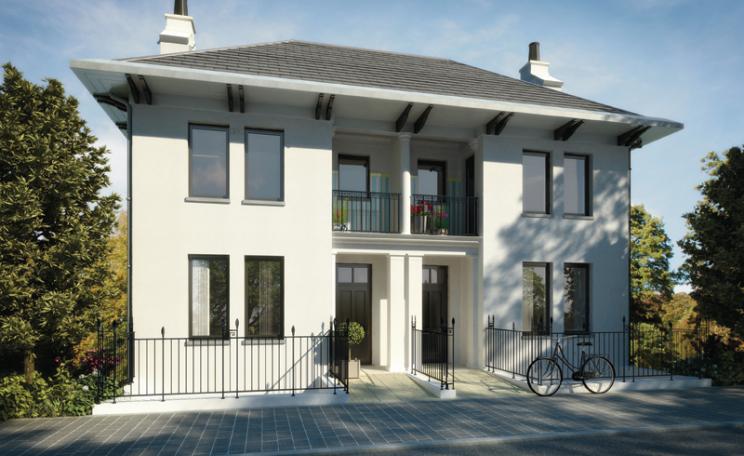A more comfortable home, a slimmer energy bill, more jobs for your community, less oil to import from the volatile Middle East... But in spite of these attractions, people aren’t swarming to green their living space.
Paul King, Chief Executive of the UK Green Building Council, reels off the reasons: 'There’s an upfront capital cost barrier for many people, for a start. And the economic environment is getting more challenging, which means people are even less inclined to spend money. Then there’s the fact that people don’t know who to trust and where to go for reliable advice. It doesn’t help that it’s not a sexy topic, not something people feel excited about. They might be excited about putting a panel on their roof, but solid wall insulation is a bit of a turn-off for lots of people.' And that’s before they get into the practicalities of actually making the change...
This brings us to the intimidation factor. Green retrofits are a challenging process, involving a host of complex and often interrelated decisions. The person in charge has to decide which technologies to use, how to optimise system synergies, what the best financing mechanism is, and who to hire to get the job done right. That’s asking a lot of a person with no expertise, especially when they’re inundated with information and uncertain where to turn for reliable advice. The result is predictable: people switch off and go back to watching the telly.
It’s a problem, even if you leave stretching carbon targets out of the equation. Energy costs are claiming an ever larger chunk of people’s budgets. 'Fuel prices in the UK increased by 15-18 per cent in the past year alone, and people’s incomes aren’t keeping pace', warns Rik Kendall of construction and support services company Carillion PLC.
'We also have an aging housing stock in the UK that’s much less energy efficient than the housing stock in much of Europe.' About half of UK homes do not have even basic insulation installed, according to the Department of Energy and Climate Change [DECC]. In Kendall’s words, the ‘three-legged stool’ of low incomes, rising energy costs and leaky buildings has led to sharp increases in the national fuel poverty level, defined as households that spend 10 per cent or more of their income on home heating. According to data from DECC and the Centre for Sustainable Energy, close to 20 per cent of households now live in fuel poverty.
The US faces similar problems. Energy costs are also rising sharply, along with levels of fuel poverty. While the housing stock tends to be newer than in the UK, this positive is offset by the fact that many Americans live in hot climates and treat air conditioning as a bit of a ‘right’ – alongside life, liberty and the pursuit of happiness… The challenge of inspiring individuals to take action is arguably even greater in the US, where energy wastefulness is the norm and the return on investment numbers unfavourable.
Social enterprise
One way around this dilemma is by engaging people at the community rather than individual level. This approach has much to recommend it, including lower prices through collective buying power and a level of scale that attracts subsidies and the combined talents of powerful players. The UK’s Community Energy Savings Programme (CESP) is an example of a multi-partner approach that engages people at the broader community level. The Government requires major energy suppliers and power generators to drive reductions in CO2 emissions. CESP makes this possible through what is essentially a matching fund programme. The big energy companies put up half the money for house-by-house, street-by-street energy efficiency improvements in low-income communities through the UK. These funds, which will total £350 million over a three-year period, are matched at the community level, typically by the local authority. The result: big chunks of leaky housing get an energy efficiency upgrade.
Working under the CESP umbrella, Carillion recently partnered with power company InterGen UK, pipeline provider Northern Gas Networks, local community interest group Community Energy Solutions (CES) and social housing provider Fabrick Housing Group. The purpose of this impressive alliance was to replace old, inefficient electric heaters with energy efficient A-rated gas central heating systems in over 200 social housing households in Teeside in the north of England. All the partners had an essential role to play. The Government drove the initiative. InterGen contributed CESP funding. Northern Gas and CES provided additional financing and access to mains gas. Carillion facilitated the financing arrangements and installed high-efficiency heaters. And, 'because it’s [housing provider] Fabrick that’s going to their tenants, they’re far more inclined to say, "Let’s have it"', Kendall explains.
In the US, where a hotchpotch of renewable energy financing mechanisms create opportunity and befuddlement in roughly equal measure, a new social enterprise is trying to cut through the clutter. San Francisco-based 1 Block off the Grid provides one-stop shopping for prospective solar customers in 40 states around the country. It works with them to pinpoint their payback period, provides financing guidance, and then connects them with a skilled local installer. This installer offers a sizeable group discount, because 1 Block off the Grid is doing the difficult and time-consuming work of herding customers their way. The smart start-up is also making use of satellite photography to do much of the analysis remotely.
Its business model works rather like Groupon, the popular web-based coupon company. Groupon finds service providers (in anything from facials to fitness classes) that are willing to give customers a big one-time discount, and then sends battalions of customers their way. 1 Block off the Grid proposes to do the same for solar. In fact, the company received its initial round of funding from New Enterprise Associates, which also funded Groupon. Since its launch in 2008, the company has closed on about 1,800 installations. While not a huge number, 'sales are increasing exponentially each month', says Shannon Coulter, Vice-President of marketing. 'We expect to be at about 2,200 by year’s end.'
1 Block off the Grid will have to demonstrate that the Groupon model can persuade people to make over their homes as well as their personal appearance. And of course, it’s only one player. Thousands of others around the world will have to contribute, too.
But innovative financing and delivery models are only part of the puzzle. Another big part of it is communication. Consumers need to be aware of the available opportunities, and inspired to pursue them.
'We have to help people understand how important this is', says David Adams, a Director in the wonderfully named Re-Thinking department of construction and support services company Willmott Dixon. Adams sees much potential in the Green Deal, currently wending its way through the UK Parliament [see 'The Green Deal: 'We won't get another chance"']. This scheme directly addresses the heavy upfront burden of green retrofits by adding the cost of the retrofit to the home’s energy bill over a 25-year period. 'But the savings aren’t huge”, admits Adams: “They’re unlikely to inspire mass engagement.'
Dream homes
So what will? Back to that telly… TV presenter Oliver Heath has brought more than a touch of class to retrofit with his popular programme, ‘Dream Homes’. In the first episode, Jon and Jane restore a medieval barn in East Sussex; in the second, a run-down Georgian house is revived using local builders and traditional skills… They may not be tales of your average low-income householder, but the point is they’re aspirational.
It’s important that people come in and say 'Wow!'
'One of the big problems with sustainability', Heath argues, 'is that it appeals to a particular side of the mind – the pragmatic side: the efficiencies, the cuts. But this practical way of thinking doesn’t make people excited. Sustainability has a duty to become more appealing.' Heath cut emissions by 62 per cent in his own home, a 1960s semi in Brighton, thanks to full insulation, a heat recovery system, solar water heating panels, double glazing and low-energy lighting.
But what he’s most proud of is its looks. It’s now part of Britain’s Old Home SuperHome Network, which means he gets to show it off to visitors at least three times a year. 'It’s important that people come in and say "Wow! I love it!"', he asserts. 'We have to integrate aesthetics: it’s not secondary to the sustainable design movement. Without good design that makes you think "I want that", how are we going to sell it? If the windows are tiny, we won’t get the right levels of take-up.'
But, King warns, 'We mustn’t assume a one-size-fits-all message when it comes to engaging householders. Some think it’s smart and attractive to green their home; some are motivated by future-proofing themselves against energy price rises; others won’t find it very interesting at all. Trying to cater for all those people will take clever communications.'
Still, where the magnitude of the stakes and the potential savings have failed to pull in the crowds, it’s possible that the old combination of good looks on TV will do the trick.
A version of this article originally appeared in Green Futures, the leading magazine on environmental solutions and sustainable futures published by Forum for the Future.
| READ MORE... | |
 |
COMMENT The Government has seriously miscalculated the cost of green homes There's a lot of nonsense talked, bought and done when it comes to eco-retrofitting houses. David Thorpe's new book sorts the wheat from the chaff, and challenges some green orthodoxies... |
 |
COMMENT Do the environmental benefits of gardens outweigh the need for affordable houses? The need for more affordable housing is often cited as a reason for building on often-environmentally important garden plots. But does such a policy result in more cheap homes? Apparently not, argues Simon Leadbeater |
 |
COMMENT The danger of fetishising zero carbon new-build What’s the point of zero-carbon homes that aren’t fit for habitation? There is more to sustainable building than meeting Government targets, argues Dr David Strong |
 |
HOW TO MAKE A DIFFERENCE CASE STUDY: building sustainable houses from rubbish They’re made from recycled materials, and are entirely self-sufficient. Laura Sevier meets the renegade architect behind Earthships |
 |
INVESTIGATION Home truths - low-carbon materials key to greener dwellings Forget complex, high-end technologies – basic truths and natural, low-carbon materials hold the key to sustainable and truly energy-efficient homes, argues James Hulme |





